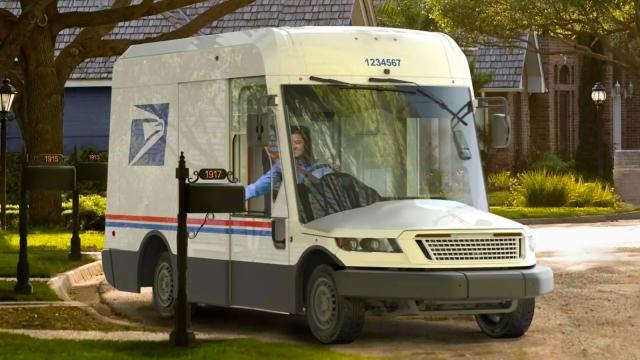The United States Postal Service’s trucks are in dire need of replacement, and the agency has a plan to do just that. Last year, it announced its plans to move forward to purchase the mail truck of the future.
Late last week, it detailed those plans more fully in an environmental impact statement, sussing out a few different scenarios. One included transitioning all 165,000 of its daily workhorse fleet to electric vehicles. But in the end, the USPS decided that wasn’t its preferred option, instead saying it would like 10% of its new fleet to be electric while the remaining 90% will run on internal combustion engines.
There are challenges to the 100% EV option, including where to install charging infrastructure in urban locations and having the range for mail delivery in rural areas. But the main reason the USPS prefers the 90/10 split is cost. It called the 100% electric truck scenario its “preferred alternative,” but noted that it “is not achievable, absent additional funding.” The total cost to electrify the fleet entirely would be $US11.6 ($16) billion, a $US3.3 ($5) billion difference from the 90/10 split. To which I say, why has nobody given the Postal Service this money yet?
You can probably find the $US3.3 ($5) billion sitting in the Joint Chiefs of Staff’s collective couch cushions. Consider that the F-35, a $US1 ($1).5 ($2) trillion boondoggle of a fighter jet that can’t even shoot straight. If the Department of Defence is really serious about national security threat posed by climate change, it must immediately cancel, I don’t know, one or two F-35 contracts and give that money to the USPS. Having 165,000 electric vehicles quietly delivering mail would, according to the EIS, reduce greenhouse gas emissions by more than 537,000 metric tons of direct tailpipe emissions alone. The USPS helpful notes this would “be the most beneficial” scenario on that front, in addition to cutting air and noise pollution. That would save lives and money, particularly in poor neighbourhoods and communities of colour. Can the F-35 program say the same?
But OK, I hear you. Cancelling a few Lockheed Martin contracts would be distinctly un-American. We love the military-industrial complex! So then it must be incumbent on Congress to get its act together. Specifically, the Build Back Better Act, which included roughly $US6 ($8) billion for the USPS and electrification. A relative princely sum compared to what the agency outlined in its EIS!
Yet the act was killed by Sen. Joe Manchin live on Fox News late last year. The senator from West Virginia has since said that he could come to an agreement with his fellow Democrats on climate “much easier than anything else.” What better way to prove that he is not a bad faith negotiator owned by special interests than by voting for Build Back Better and ensuring the USPS has its extra $US3.3 ($5) billion to get that EV fleet humming? Manchin has spoken highly of the Postal Service, even urging bipartisan comity to fix delays. Maybe he can even peel off a few Republicans to modernise mail delivery.
The joy of seeing those cute trucks zipping around to deliver mail to his constituents, free of exhaust, should be incentive enough to get to yes. After all, West Virginia has the third-highest asthma rate of any state in the U.S. But as an act of goodwill, the USPS could even allow Manchin to name one of its new EVs, much like Michigan allowed the public to do with its snowplows.
There are still other ways to get the USPS a few extra bucks. Consider Sen. Elizabeth Warren’s wealth tax legislation, which would tax the holdings with more than $US1 ($1) billion at 3%. Apply that to Jeff Bezos’ $US177 ($243) billion fortune alone, and boom, $US5.4 ($7) billion for sweet, sweet EVs. We can use the rest of $US2.1 ($3) billion to, I don’t know, plant some community gardens on post office property.
All this would align with President Joe Biden’s executive order on electrifying the federal vehicle fleet and throwing the weight of government behind addressing the climate crisis. In short, there is no reason not to give the USPS the money to do this. Give them the extra $US3.3 ($5) billion.
